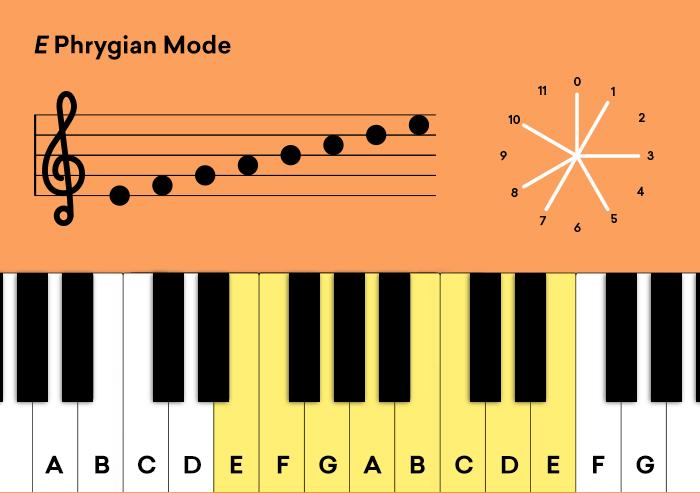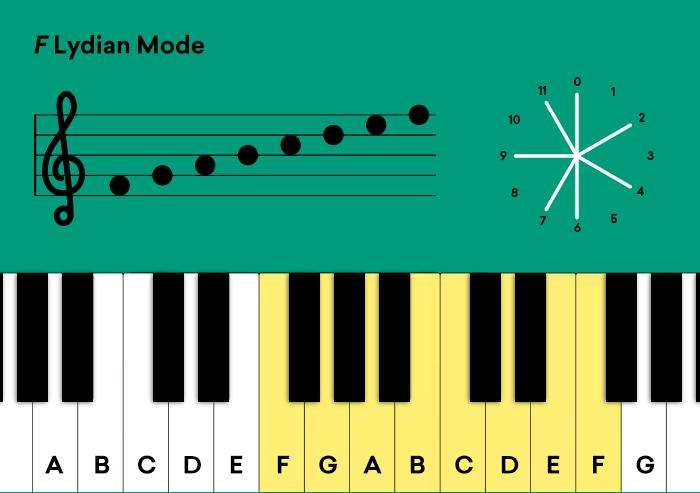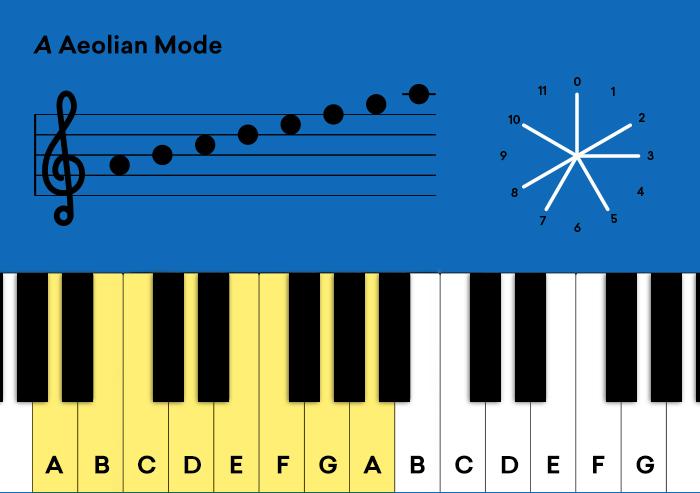Why should you learn music modes?
Good question. Even if you know it’ll pay off, the idea of sitting down and memorizing scales isn’t anyone’s idea of a creative flow.
Music theory is one of the most common roadblocks for self-taught musicians and producers.
But the truth is, all you need to expand your tonal palette is a little practical understanding of music modes.
If you need to break out of a creative rut, modes are the easiest alternative to your same old major scale.
This article will show you how to build—and remember—each mode, what they sound like and ways to explore them further.
What are music modes?
Music modes are a type of scale with distinct melodic characteristics. The 7 modes, Ionian, Dorian, Phrygian, Lydian, Mixolydian, Aeolian and Locrian, come from the earliest forms of western music.
Before we figured out the math for dividing the octave into 12 equal tones, we had to make do with an imperfect system. Modes were the solution.
Instead of one all-purpose scale that could be transposed into different keys, there were 7 modes that each had their own structure.
In early music, the modes were used similar to how we use keys now.
Today, modal music refers to pieces of music where modes are used structurally and harmonically in place of traditional functional harmony.
How modes help with songwriting
If you’ve been writing a lot using the vanilla major and minor scales, your next song can benefit from some modal flavour!
Each mode has its own unique colour and mood. Their melodic signatures can bring a lot of drama and freshness to your sound.
They’re not hard to learn either. Once you start experimenting with modes, you’ll recognize a lot of the sounds and colour they have to offer.
How to build the modes
The sound of the modes come from their unique constructions. So what are they and ow can you remember them?
If you’ve been writing a lot using the vanilla major and minor scales, your next song can benefit from some modal flavour!
The modes have an order. Ironically, you can use the mnemonic I Don’t Particularly Like Modes A Lot to remember it!
The order of musical modes is:
1. Ionian
2. Dorian
3. Phrygian
4. Lydian
5. Mixolydian
6. Aeolian
7. Locrian
I’ll go through and build each mode from the C major scale and provide an example from music history to help you understand the potential of each mode in your own songwriting.
Ionian Mode
Let’s start with the major scale. It’s equivalent to the first mode: Ionian.
Since your “key signature” won’t change as we go through the modes, you’ll be able to play each mode using the C major scale formula.
If you need a quick refresher on key signatures, use our circle of fifths guide as a quick reminder.
As you can see C major has no sharps or flats, just the white keys on the keyboard. So: C-D-E-F-G-A-B-C
Since all the notes are essentially the same, we’ll have to play each mode over the corresponding diatonic chord to hear its quality.
Dorian Mode
For Dorian, write the C major scale but instead of stopping at the octave (C), write the next scale degree as if you were continuing up the octave (D).
If we erase the C we started with, we now have an 8 note scale from D1-D2. This is the 2nd mode: D Dorian.

Notice how it’s pretty close to the D minor scale.
It’s similar—but with some very important differences. The 6th degree is natural, but the 7th degree is flatted.
This is what makes the Dorian mode distinct from other minor scales and gives it that special quality.
Here’s a song built around the Dorian mode. Listen for the sound of the natural 6th in the opening guitar figures and vocal melody:
Phrygian Mode
Now write the next note in the scale. If you delete the D you’ll have another 8-note scale from E1-E2. This is the third mode: E Phrygian.
It’s a similar to minor, but the flatted 2nd scale degree immediately sets it apart.

The characteristic minor 2nd interval has a recognizable sound. The second chord in the opening progression of “Pyramid Song” by Radiohead is built on the Phrygian flatted 2nd:
Lydian Mode
Lydian is the fourth mode. If you write the next note in the scale you’ll get F Lydian.
We like this mode so much we did an entire piece on Lydian.

“Bull in the Heather” by Sonic Youth features Lydian’s raised 4th scale degree prominently in the verse guitar melody:
Mixolydian Mode
Mixolydian is the 5th mode. If you continue the method of writing the next scale degree and deleting the first you’ll get G Mixolydian.
Mixolydian has some characteristics of the “blues scale” because of the flatted 7th.

Listen for it in the sitar/vocal melody of “Norwegian Wood” by the Beatles:
Aeolian Mode
Aeolian is the sixth mode. Continuing up the scale, you’ll get A Aeolian.
It’s also called natural minor, because it’s a minor scale without the raised 6th degree or 7th degree of melodic or harmonic minor.
Aeolian is the default minor sound in pop music, so it can be found all over music history.

“Losing my Religion” by R.E.M. uses the Aeolian mode.
Since we’re so used to natural minor, it can be can harder to pick out the characteristic modal intervals. In this case, listen for the quality of the V chord.
When it’s minor we’re in Aeolian.
Locrian Mode
Locrian is the 7th mode. It’s used far less often than the other modes, so there’s not many examples out there.
But that doesn’t mean it’s not worth exploring on your own with the methods you’ve already gone through in the rest of this article.

The parent scale: How to find any mode
You just learned the parent scale method of building the modes. Now you can build any mode as long as you know its number in the order.
Simply count backwards to the major parent scale to determine the structure of the mode.
Simply count backwards to the major parent scale to determine the structure of the mode.
For example, E Aeolian? Aeolian is the 6th mode. What major scale is E the 6th degree of?
Correct, it’s G. So E Aeolian is simply the 8-note scale beginning and ending on E with the same formula as G-Major.
Again, staying sharp with your key signatures is a must for working with modes. The circle of fifths is a great partner tool for writing modally.
Once you understand the parent scale method for getting the modes, you’ll start to see patterns.
This is where the other method for remembering the modes comes into play…
Scale formulas
As I’m sure you’ve noticed, the modes share a lot of similarities with either the major or minor scale.
If you know whether a mode is generally major or minor, you can simply remember which tones are altered from the template.
This is the “scale formula” method for remembering the modes.
Here are the formulas for the church modes.
- Ionian – Major (no altered notes)
- Dorian – minor + natural 6th, flatted 7th
- Phrygian – minor + flatted 2nd, flatted 7th
- Lydian – Major + sharp 4th
- Mixolydian – Major + flatted 7th
- Aeolian – minor + flatted 6th, flatted 7th
For example, say we want to play A Lydian. We remember that Lydian is a “major” mode so we start with the scale formula for A Major: F#, C#, G#.
We know that Lydian contains the raised 4th scale degree, so we can simply add D# to our “key signature” to create the mode.
Now that you know the scale formula method, trying transposing each mode into C and playing them over the corresponding C major or minor chord.
This will help you understand what makes each mode distinct.

Of these two methods, you may think that the scale formula method is much faster and easier. But the parent scale method will come in handy later on when you’re digging into more advanced modes.
How to use the music modes
If you’ve played through the modes, you’re probably starting to get a feel for what they sound like.
In practice, think of the modes like colours on a spectrum from dark to light.
In practice, think of the modes like colours on a spectrum from dark to light.
To generalize:
- Modes with more “lowered” or flatted scale degrees are darker.
- Modes with more raised scale degrees can be considered brighter.
It’s an easy shorthand for finding where the modes fit in to your songwriting. Need a sound that’s even darker than minor? Phrygian might come in handy.
Looking for something especially bright and augmented? Lydian could be your best choice.

You may find your own synesthetic connections to the modes as you learn them, there’s no right or wrong answers here!
Hot tip: If you’ve been following along extra close and listening carefully to the examples, you may have noticed that some of the songs you’ve heard contain the characteristic intervals of the modes in the melody, while others use them in the harmony.
Need a sound that’s even darker than minor? Phrygian might come in handy.
You can build chords with the modes like we’ve done before with the major and minor scales…but that’s a story for another day! Stay tuned…
Mode Selector
Modes can be a game changer for your songwriting.
The modes of the major scale are everywhere in music history. As soon as you can recognize their sounds, you’ll start hearing them all over your favourite tracks.
They’re also a gateway to other methods. Once you master the church modes, your ears will be itching for new colours and moods.
If you know these methods for building and remembering modes, go ahead and try them all! Because no songwriting toolbox is ever too big.
The post Music Modes: How to Enrich Your Songs with Modal Color appeared first on LANDR Blog.